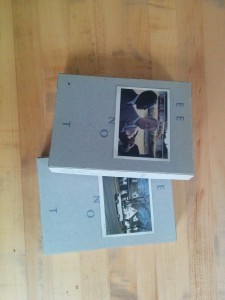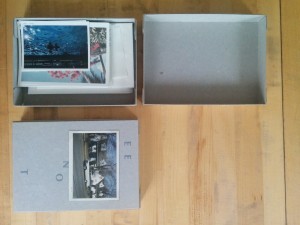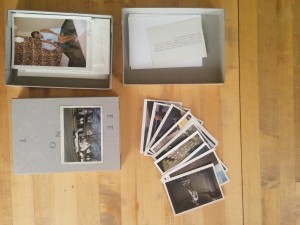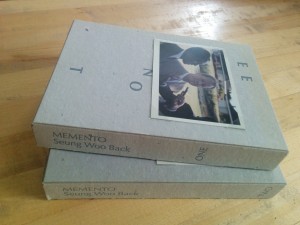Oksun Kim is best known for unsparing, full force portraiture. The best metaphor for her portraits is a frontal assault. She approaches her subjects head on.
The Shining Things is a departure. Rather than people, she has brought her lens to bear on trees. Though it might seem a logical step to describe these photographs as portraits of trees, I do not think that is accurate or useful. While Kim has brought her usual head-on style, these are not portraits.
Kim is based on Jeju Island, and that is where these photographs were taken. The trees are from a range of species and they appear as often in natural surrounds as the edges of urban spaces. Some trees are singled out and others blend into a cacophonous forest tableau of texture and color.
The photographs call to mind Ed Panar’s Golden Palms. Panar’s lo-fi photographs of LA made shortly after he moved there are similarly direct and diverse. While his photographs often include trees or vegetation, they are not the sole or even primary subject matter. What ties his book together is an affectionate sense of amusement at his new home.
Affection is likewise apparent in Kim’s The Shining Things. Kim’s portrait projects Hamel’s Boat and No Direction Home were shot on Jeju Island where she is currently based. While the location has not been a central visual concern in these photographs (though certainly conceptually it has), I can’t help but feel that the intense close looking so important in her portraits must bleed over into her quotidian view. When she walks away from a portrait session or goes for a drive the next day, how can a vestige of that intensity not carry over? How can the world not appear beautiful and wonderful in her intense gaze?
The book opens with a quote from Hubert Dreyfus’ and Sean Dorrance Kelly’s All Things Shining: “All things are not shining, but all the shining things are.” Their book is a call to reawaken an “intense involvement with the wonder and beauty of the world” (that is according to Amazon’s blurb–I’ve not read the book myself**). Kim’s close looking and affection for place have led her to make these photographs. They are an outpouring of involvement with the wonder and beauty of the everyday world. These are the shining things that have become apparent through Kim’s intense gaze.
**
Postscript: Since publishing this review in June I have read All Things Shining by Dreyfus and Kelly. With an expanded understanding of the ideas in the book, which are a source for Kim’s photography, I want to make a couple of additional comments on Kim’s The Shining Things. Dreyfus and Kelly write about the process by which meaning in human being has been reduced and diminished over the past two millenniums and the potential for reawakening the opportunities for meaning through polytheistic attitudes. In their view, meaning in contemporary life has become flattened with the spiritual shift to monotheism and the drive towards radical individualism (abetted by technological advancement). Their contention is that there remains a multiplicity of poietic conceptions of human being, going back through history, that offer us a manifold understanding of the way the world is. Drawing from these multiple conceptions of the world we can move beyond the dearth of meaning offered by the confluence of monotheism and individualism. By seeking a new kind of vibrant polytheism we can unlock a wonderful world of shining things.
In their book’s conclusion, Dreyfus and Kelly write: “[Becoming receptive to a modern pantheon of gods] requires developing the senses of the sacred that still linger unappreciated at the margins of our disenchanted world.” With this thought in mind, an alternative reading of Kim’s trees would be as the physical embodiment of Dreyfus’s and Kelly’s idea. The trees themselves linger at the margins; Kim elevates them through the wonder of her lens and shows them to be shining. This in no way diminishes the affection for place that I considered previously. I think that her engagement with the local is expansive. Through Kim’s expert use of craft (a poietic mode of meaning) and her attentiveness to the potential for beauty and meaning in the quotidian, her photographs both mirror and amplify the ideas in All Things Shining.
The Shining Things
Oksun Kim
Edited by The Museum of Photography, Seoul
Curated by: Senior Curator Son Young-joo, Curator Kim Sunyoung, Assistant Curator Kim Jeehyun, Educators Hyeju Hong & Mihyun Kim, Interns Jeena Lee & Eunji Choi
Text by: Loo Youngwook
Translated by: Juhee Son (Kor-Eng)
Designed by: Kim Jindeuk
Printed by: Graphic Korea, Ltd.
Published by: Song Youngsook, Ga-Hyeon Foundation of Culture
First Published August 9, 2014

 Photographs are rich in physical facts: what someone wore, where someone stood, who they stood beside, what they were doing. Snapshots serve to jog our memories of why the physical world was in this state and how we felt about the experience of being in that place at that time. Unmoor snapshots from the personal memories that give them specific meaning and they become mysteries open to interpretation and invention.
Photographs are rich in physical facts: what someone wore, where someone stood, who they stood beside, what they were doing. Snapshots serve to jog our memories of why the physical world was in this state and how we felt about the experience of being in that place at that time. Unmoor snapshots from the personal memories that give them specific meaning and they become mysteries open to interpretation and invention. This is a conceptual performance of sorts. Back poses a question and allows his chosen editors and then we, the readers, to work out the answer to it. Back collected over ten thousand vintage personal snapshots from across the US and selected 2,700 to print. These prints were then presented to eight people (one being Back himself) who were asked to select a set of eight images. These people were invited to add text to photographs if they wished. Memento One and Two are each a cardboard box containing half of the selected photographs. The “prints” are snapshot sized offset reproductions, but their varying paper base colors and surface textures mimics the feeling of flipping through a stack of old photographs. Some photographs are annotated with dates or captions in English or Korean while others are unadorned with text. Several images repeat–often with different text on them. One image of two men skeet shooting towards the ocean appears three times. As readers, we are free to rearrange and mix and match our own sets of images.
This is a conceptual performance of sorts. Back poses a question and allows his chosen editors and then we, the readers, to work out the answer to it. Back collected over ten thousand vintage personal snapshots from across the US and selected 2,700 to print. These prints were then presented to eight people (one being Back himself) who were asked to select a set of eight images. These people were invited to add text to photographs if they wished. Memento One and Two are each a cardboard box containing half of the selected photographs. The “prints” are snapshot sized offset reproductions, but their varying paper base colors and surface textures mimics the feeling of flipping through a stack of old photographs. Some photographs are annotated with dates or captions in English or Korean while others are unadorned with text. Several images repeat–often with different text on them. One image of two men skeet shooting towards the ocean appears three times. As readers, we are free to rearrange and mix and match our own sets of images. 
 Memento One & Two
Memento One & Two